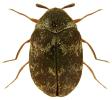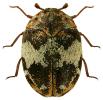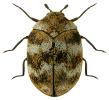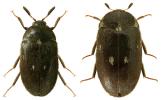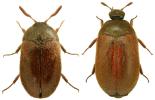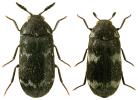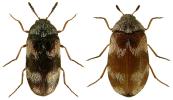Images:
A family of 40 mostly small (1.5-12mm) beetles, many of which are familiar as pests of insect collections and stored products (particularly Anthrenus spp. and Dermestes spp.). The ‘woolly bear’ larvae can be a frequent sight where protein-rich food sources are available (e.g. dead insects in light fittings). There are seven subfamilies in Britain.
Three subfamilies (Trinodinae, Thylodriadinae and Thorictinae) have a single British representative each. The 3mm, pubescent Trinodes hirtus (Fabricius) is widespread in association with woodland, where it is thought to feed on dead insects from spiders’ larders beneath bark or in bark crevices. The rare synanthropic species Thylodrias contractus Motschulsky, the odd beetle, is highly sexually dimorphic, with a large (2-5mm) larviform female and a smaller (2-3mm) winged male which strongly resembles a cantharid. Thorictides heydeni Reitter is another rarely-imported species. 1-2mm in length, it is an elongate red-brown species found on stored animal and vegetable products.
The carpet beetles, Attageninae, have seven British representatives, but only one of these (Attagenus pellis (L.)) does not occur mainly as an adventive. Larvae can be pests on foodstuffs and natural fibres, particularly wool and fur, but are also found in the nests of birds and bees.
Dermestinae is a subfamily of 10 medium-sized (5-12mm) beetles in Britain, many of which can be found indoors. Elongate, parallel-sided beetles, often drab browns and greys in colour, they feed on a wide variety of protein-rich foods, including carrion, leather, bones, horn, and other detritus indicative of late-stage decay. When searching for pupation sites larvae can bore through a variety of substances, including lead, wood and books and thus can cause damage in domestic situations
There are 11 species of Megatominae in Britain, many of which are infrequent introductions (Trogoderma spp., Reesa vespulae (Milliron), Orphinus fulvipes (Guerin-Meneville) and Anthrenocerus australis (Hope)). Some species are found in the wild and Ctesias serra (Fabricius) is widespread beneath old oak bark during the summer.
Anthreninae includes nine species of Anthrenus, small, round species clothed with brown and grey scales. Adults can often be found nectaring on flowers but some species (particularly Anthrenus verbasci (L.)) are also found indoors and are notorious destroyers of insect collections: they are often referred to as the only beetle collectors are sad to see in a collection.
